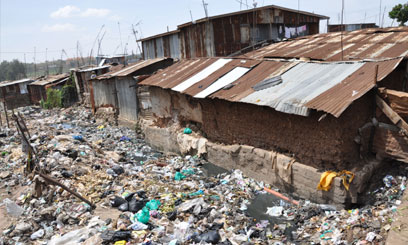
The shortage of pit latrines, the residents say, is because there is no space to construct them and some landlords don’t want to erect them due to the cost implication/MUTHONI NJUKI
NAIROBI, Kenya, Jul 24 – With an estimated population of over two million people, Kibera slum is said to have one pit latrine for every 50 to 500 people.
This according to the United Nations Development Programme, has led to the use of ‘flying toilets’, where the residents use polythene bags to relieve themselves and then dispose them anywhere.
Located about five kilometers south of the Kenyan capital, Nairobi, the slum is divided into the nine villages of Kianda, Soweto, Kisumu Ndogo, Lindi, Laini Saba, Silanga, Makini and Mashimoni.
“The major problem we have here is sanitation. We have no sewer lines. Toilets are constructed next to the river and when we use them the waste goes right into the river,” Lydia, a resident of Soweto village tells us.
In this area where Lydia lives, there are four badly constructed communal pit latrines that she estimates serve 500 people.
“People come from far to use these toilets. We are many. We could even be more than the 500,” she says.
The shortage of pit latrines, the residents say, is because there is no space to construct them and some landlords don’t want to erect them due to the cost implication.
Water and sanitation services in this slum are almost non-existent. Open sewers and unrestrained waste disposal is evident everywhere.
“We don’t have access to clean drinking water because we have no piped water and the river here is dirty because that’s where all the sewage waste flows and when it rains that dirty water mixes with what we drink,” Lydia explains of the water they use for drinking that is pumped through plastic pipes that pass through sewage channels.
During the rainy season, Lydia says, the slum is inhabitable. The pathways are completely flooded and the streams that cut across the shanties overflow. The open sewers make it worse because the sewage waste flows uncontrollably.
Getting from one point to another in this village is a nightmare and one has to keep jumping over ditches or trying to get away from the garbage.
Most of the sewage from the villages that comprise Kibera slums is directed to the Nairobi dam which has rendered water in the dam totally unfit for consumption.
We also spot children playing with garbage oblivious of the health risks they may be exposed to.

In this area where Lydia lives, there are four badly constructed communal pit latrines that she estimates serve 500 people/MUTHONI NJUKI
But the picture is different in a section of another village known as Lindi still within Kibera. The village is bearably clean and there is not much garbage littered.
This is through the efforts of a youth group that decided to take the initiative to improve their living conditions.
According to Shaffie Ahmed, an official of the youth group, they sourced for funds to build a block of toilets and bathrooms that is used by many of the residents there.
“We started as a merry go round then we shared some ideas and we decided to get some donors to assist us financially with the project because many people here struggle to get toilets and most of the time when you pass in alleys it is not impressive due to the flying toilets,” he explains.
The project, he says, cost about Sh1.8 million. The initiative whose primary role was to create a sanitation facility for the dwellers has also turned into a source of livelihood for this group of youths.
“For the toilet we charge Sh5, bathroom Sh10 but hot water we charge Sh15. We provide water, soaps and everything else so that when a customer comes, they leave here happy,” Ahmed says.
The toilet and bathroom block has helped maintain cleanliness in the area as explained by Linet Moraa, a resident of Lindi who uses the facility.
“We used to suffer a lot when we didn’t have these toilets. You find that there are no toilets where people live which sometimes make people help themselves inside the house or go look for a toilet far away and sometimes they are very dirty,” she says.









































